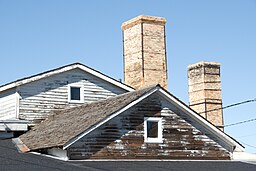Claybank Brick Plant
| Claybank Brick Plant | |
| National Historic Site of Canada | |
| Country | Canada |
|---|---|
| Province | Saskatchewan |
| Rural Municipality | Elmsthorpe No. 100 |
| Cities | Hamlet, 1 km east of Claybank |
| Coordinates | 50°01′49″N 105°13′11″W / 50.03028°N 105.21972°WCoordinates: 50°01′49″N 105°13′11″W / 50.03028°N 105.21972°W |
| Brick Plant | 1912-13 |
| - National Historic Site of Canada |
June 29, 1997 |
| Visitation | Open by appointment |
Claybank Brick Plant was a brickworks factory for the manufacturing of bricks from clay located with a quarry for clay on site. The Claybank Brick plant has been conserved as a part of Saskatchewan's industrial heritage with its official announcement June 29, 1997 as a National Historic Site of Canada by Minister of Canadian Heritage Sheila Copps. $2 million for the conservation and presentation of the Brick Plant by Claybank was contributed jointly between Federal and Provincial Government funding departments. Claybank Brick Plant used neighboring clay from the Massold Clay Canyons. The Cretaceous period resulted in the Whitemud Formation which is the underlying zone of the Claybank Hills. The Whitemud Formation is noted for two main types of clay; white and grey in colour which possess different properties. Also close to Claybank are the Dirt Hills where a "bentonitic clay" can be found. Therefore, the brick produced is used for different purposes. Claybank Brick Plant is known for its face brick, as well as tiles, fire brick, insulating brick
1886 Thomas McWilliams noted the economic potential of the clay hills of this area and filed for homestead property here. It is felt his original intention may have been to sell the clay to Wellington White brick plant in Moose Jaw.
1909 the Canadian Northern Railway built a branch rail line near the Dirt Hills. Thomas McWilliams supplied the Moose Jaw Fire Brick & Pottery Company as early as 1904. Moose Jaw investors constructed the Claybank brick plant under the name Saskatchewan Clay Products with its official opening held June 16, 1913. The Brick Plant closed briefly during World War I and re-opened in 1916 as Dominion Fire Brick & Pottery Co.. Redcliff Pressed Brick purchased the Brick Plant in 1954 and renamed the operation Dominion Fire Brick & Clay Products (1954) Ltd. Soon after this takeover the operations were purchased by AP Green Fire Brick Company and many of the fire kilns were converted to gas. 1971 saw the last takeover bid by AP Green Refactories Ltd. The Brick Plant owned by A.P. Green Refractories closed in 1989. In 1992 the Claybank Brick Plant was acquired by The Saskatchewan Heritage Foundation.
...
Wikipedia

